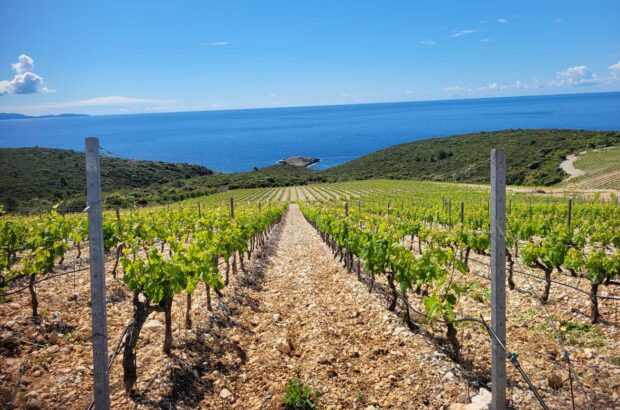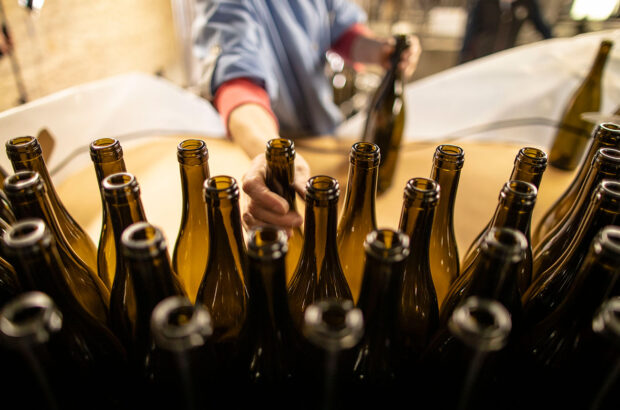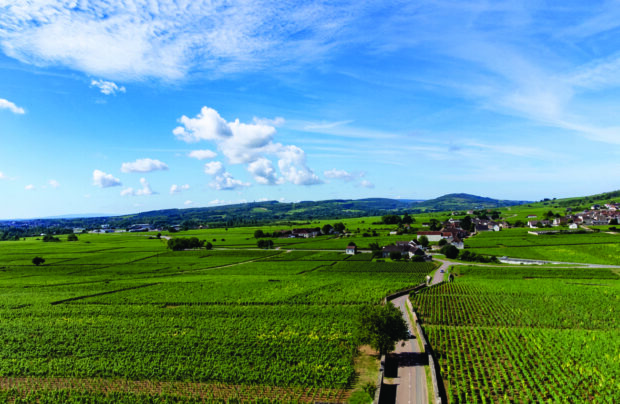Homer’s Odyssey tells of a place on Earth where the inhabitants ‘plant nothing with their hands nor plough; but all these things spring up for them without sowing or ploughing, wheat, and barley, and vines, which bear the rich clusters of wine, and the rain of Zeus gives them increase’.
Scroll down to see tasting notes and scores for 10 top Etna wines
According to Odysseus, this place, the home of the Cyclopes, is in Sicily, on the slopes of Mount Etna.
Europe’s highest active volcano lies in the province of Catania, and, leaving legend aside, the fact remains that at the end of the 19th century the province had the most vines on the island, with about 90,000ha. That’s not much less than the total area under vine across all of Sicily today – back then, a flourishing economy revolved around wine.
In the 1890s, a railway, the Circumetnea, was even built to transport the precious product to the port of Riposto (which, in local dialect, means ‘cellar’) from where it was shipped around Europe.
But phylloxera and post-war agricultural reforms led to the abandonment of the volcano’s vineyards in favour of other crops. All traces of the Cyclopes’ paradise were lost.
Starting over
{"content":"PHA+4oCYTWFueSBvZiB1cyBjYW1lIHRvIEV0bmEgaW4gYSBzaG9ydCB0aW1lLiBCdXQgdGhlcmXigJlzIGEgcmVhc29uOiB0aGVyZSB3YXMgbm90aGluZyBsZWZ0IGhlcmUsIHNvIHRoZXJlIHdhcyBzcGFjZSB0byBzdGFydCBvdmVyLuKAmSBNYXJjIGRlIEdyYXppYSBzcGVha3Mgd2l0aCBhIHBpb25lZXIgc3Bpcml0LiBIaXMgVGVudXRhIGRlbGxlIFRlcnJlIE5lcmUgaXMgbm93IDIwIHllYXJzIG9sZCDigJMgYW4gYWdlIHRoYXQsIGFyb3VuZCBoZXJlLCBnaXZlcyBpdCDigJhoaXN0b3JpYyB3aW5lcnnigJkgc3RhdHVzLjwvcD4KPHA+QXMgaGUgdGFsa3MsIGRlIEdyYXppYSBpcyBsb29raW5nIHRocm91Z2ggaGlzIGhvbWUgbGlicmFyeSBmb3Igb2xkIHRleHRzIHRoYXQgbWVudGlvbiBFdG5h4oCZcyB2aXRpY3VsdHVyZSwga25vd2luZyBmdWxsIHdlbGwgdGhhdCB0aGV5IGFyZSBmZXcgYW5kIGZhciBiZXR3ZWVuLiBVbmxpa2Ugb3RoZXIgcmVub3duZWQgdGVycm9pcnMsIHRoZXJlIGFyZSBubyBzb3VyY2VzIHRvIGRyYXcgb24gd2l0aCByZWdhcmQgdG8gc3R5bGUgb3IgdHJhZGl0aW9uLiDigJhXZSBoYXZlIHRvIHN0YXJ0IGZyb20gdGhpcyBhc3BlY3QgaW4gb3JkZXIgdG8gdW5kZXJzdGFuZCB0aGUgc3Ryb25nIHB1c2ggdG93YXJkcyBleHBlcmltZW50YXRpb24gdGhhdCBjaGFyYWN0ZXJpc2VzIHRoaXMgYXJlYSzigJkgaGUgc2F5cy48L3A+CjxwPldoaWxlIHRoZSBJdGFsaWFuLUFtZXJpY2FuIGRlIEdyYXppYSBiZWxvbmdzIHRvIHRoZSByb21hbnRpYyB3YXZlIHRoYXQgYWxzbyBjYXJyaWVkIHRoZSBsYXRlIEFuZHJlYSBGcmFuY2hldHRpIChvZiBUZW51dGEgZGkgVHJpbm9ybyBpbiBUdXNjYW55KSBhbmQgQmVsZ2lhbi1ib3JuIG5hdHVyYWwgd2luZSBleHBvbmVudCBGcmFuayBDb3JuZWxpc3NlbiB0byBFdG5h4oCZcyBzbG9wZXMgaW4gdGhlIGVhcmx5IDIwMDBzLCBBbnRvbmlvIGFuZCBTYWx2aW5vIEJlbmFudGkgcmVwcmVzZW50IGEgZ2VuZXJhdGlvbiBib3JuIGFuZCBicm91Z2h0IHVwIGluIHRoZSB2b2xjYW5v4oCZcyBzaGFkb3cuIFRoZWlyIGZhbWlseSB3aW5lcnkgd2FzIGZvdW5kZWQgYnkgdGhlaXIgZmF0aGVyLCBHaXVzZXBwZSBCZW5hbnRpLCBpbiAxOTg4LiBCZW5hbnRpIHdpbmVzLCByZWZpbmVkIGFuZCBvZiBncmVhdCBjaGFyYWN0ZXIsIGFyZSBjb25zaWRlcmVkIOKAmGNsYXNzaWNz4oCZIHRvZGF5LCBidXQgaW4gdGhlIDE5OTBzIHRoZXkgd2VyZSBwZXJjZWl2ZWQgYXMgc3VycHJpc2luZ2x5IG5ldy48L3A+CjxkaXYgY2xhc3M9ImFkLWNvbnRhaW5lciBhZC1jb250YWluZXItLW1vYmlsZSI+PGRpdiBpZD0icG9zdC1pbmxpbmUtMyIgY2xhc3M9ImlwYy1hZHZlcnQiPjwvZGl2PjwvZGl2Pgo8cD5Jbm5vdmF0aW9uIGlzIGEgZGlzdGluY3RpdmUgZmVhdHVyZSBvZiBldmVyeW9uZSB3aG8gZW5nYWdlcyB3aXRoIEV0bmHigJlzIGRpdmVyc2UgdGVycm9pci4gVGhvc2UgcmFyZSB3aW5lcmllcyBvZiBsb25nIHN0YW5kaW5nLCBzdWNoIGFzIFNjYW1tYWNjYSBkZWwgTXVyZ28gYW5kIEJhcm9uZSBkaSBWaWxsYWdyYW5kZSwgd2l0aCB0aGVpciBhdXN0ZXJlIHdpbmVzLCBzZWVtIHRvIGhhdmUgY29tZSBzdHJhaWdodCBvdXQgb2YgdGhlIHBhZ2VzIG9mIEdpdXNlcHBlIGRpIExhbXBlZHVzYeKAmXMgMTl0aCBjZW50dXJ5LXNldCBJbCBHYXR0b3BhcmRvLjwvcD4KPHA+RXRuYeKAmXMgZnVubmVsIGlzIGZvcmV2ZXIgc21vdWxkZXJpbmcuIEluIHRoZSBwYXN0IGRlY2FkZSwgd2l0aCB0aGUgZXhjZXB0aW9uIG9mIHRoZSByYWlueSAyMDE4IHZpbnRhZ2UsIHByb2R1Y3Rpb24gaGFzIGluY3JlYXNlZCBieSAyMCUgYSB5ZWFyIG9uIGF2ZXJhZ2UsIGFycml2aW5nIGF0IDRtIGJvdHRsZXMgb2YgRXRuYSBET0MgYW5udWFsbHksIGFjY29yZGluZyB0byB0aGUgcmVnaW9uYWwgY29uc29yemlvIOKAkyBpbiBlZmZlY3QsIHRoZSB2b2x1bWUgb2YgZ3JhcGVzIGhhcnZlc3RlZCBpbiAyMDIwIHdhcyBkb3VibGUgdGhhdCBvZiAyMDE0LiDigJhGcmVlZG9tIG9mIGdyb3d0aCBhbmQgY3JlYXRpdml0eSBoYXZlIGJlZW4gdGhlIHZhbHVlcyB1bmRlcnBpbm5pbmcgdGhlIGFyZWHigJlzIHN1Y2Nlc3MsIGJ1dCBFdG5hIGlzIG5vdCBpbmZpbml0ZS4gTm93IHdlIG5lZWQgdG8gZm9jdXMgb24gc2NpZW50aWZpYyByZXNlYXJjaCBhbmQgY29udHJvbCBvZiB0aGUgcHJvZHVjdGlvbiB6b25lLOKAmSByZWZsZWN0cyBBbnRvbmlvIEJlbmFudGksIHdobyB1bnRpbCByZWNlbnRseSBjaGFpcmVkIHRoZSBsb2NhbCBjb25zb3J6aW8uPC9wPgo8ZGl2IGNsYXNzPSJhZC1jb250YWluZXIgYWQtY29udGFpbmVyLS1tb2JpbGUiPjxkaXYgaWQ9InBvc3QtaW5saW5lLTQiIGNsYXNzPSJpcGMtYWR2ZXJ0Ij48L2Rpdj48L2Rpdj4KPGgzPjxzdHJvbmc+QmV5b25kIHJlZHM8L3N0cm9uZz48L2gzPgo8cD5XaGlsZSBldmVyeSBuZXcgdmlnbmVyb24gYXJyaXZpbmcgaW4gRXRuYSBoYXMgY29udHJpYnV0ZWQgdG8gc2hhcGluZyB0aGUgd2lkZS1yYW5naW5nIHN0eWxlcyBvZiBpdHMgd2luZXMsIHRoZSBjb21tb24gcGF0aCBmb3J3YXJkIGhhcyByZW1haW5lZCBmb2N1c2VkIG9uIHF1YWxpdHkuIOKAmFRoZSBiZXN0IHdpbmUgaW4gdGhlIHdvcmxkIHdpbGwgY29tZSBvdXQgb2YgRXRuYSwgYW5kIGl0IG1pZ2h0IGJlIOKAnG5vdCByZWTigJ0u4oCZIEFuIGFtYml0aW91cyBwcm9ub3VuY2VtZW50IGZyb20gQWxiZXJ0byBHcmFjaSwgYW5vdGhlciDigJh2b2xjYW5vIG1pbGxlbm5pYWzigJksIGJyaW5ncyB1cCBhbiBpbnRlcmVzdGluZyBjb25jZXB0IOKAkyB3aGF0IHdlIGNvdWxkIHBlcmhhcHMgY2FsbCBvZW5vbG9naWNhbCDigJhnZW5kZXLigJkuPC9wPgo8cD5FdG5hIGlzIG9uZSBvZiB0aGUgZmV3IHdpbmUtZ3Jvd2luZyBhcmVhcyBpbiB0aGUgd29ybGQgd2hlcmUgcmVkIGFuZCB3aGl0ZSBncmFwZXMgcHJvZHVjZSBlcXVhbGx5IGhhcHB5IG91dGNvbWVzLiBUaGUgbW9zdCBvYnZpb3VzIHBhcmFsbGVsIGlzIDxzdHJvbmc+PGEgaHJlZj0iaHR0cHM6Ly93d3cuZGVjYW50ZXIuY29tL3dpbmUvd2luZS1yZWdpb25zL2J1cmd1bmR5LXdpbmUvIj5CdXJndW5keTwvYT48L3N0cm9uZz4uIFlldCB0aGUgZmlyc3QgdHlwZSBvZiB3aW5lIHRoYXQgY29tZXMgdG8gbWluZCB3aGVuIHRoaW5raW5nIGFib3V0IHRoZXNlIGFtYmlkZXh0cm91cyBhcmVhcyBpcyByZWQuPC9wPgo8ZGl2IGNsYXNzPSJhZC1jb250YWluZXIgYWQtY29udGFpbmVyLS1tb2JpbGUiPjxkaXYgaWQ9InBvc3QtaW5saW5lLTUiIGNsYXNzPSJpcGMtYWR2ZXJ0Ij48L2Rpdj48L2Rpdj4KPHA+SW4gdGhlIFNpY2lsaWFuIGNhc2UsIE5lcmVsbG8gTWFzY2FsZXNlLCB0aGUgYmFzZSBmb3IgRXRuYSBSb3NzbywgcHJldmFpbHMgb3ZlciBDYXJyaWNhbnRlLCB0aGUgYmFja2JvbmUgb2YgRXRuYSBCaWFuY28sIGV2ZW4gaWYgdGhlIHdoaXRlIGdyYXBlIGlzIGNhdGNoaW5nIHVwLiBJbiAxMCB5ZWFycywgdGhlIGNvbnNvcnppbyBzYXlzLCB0aGUgcmF0aW8gaGFzIHNoaWZ0ZWQgZnJvbSA4NSUgTmVyZWxsbyBNYXNjYWxlc2UgYW5kIDE1JSBDYXJyaWNhbnRlIHRvIDY1JSBhbmQgMzUlIHJlc3BlY3RpdmVseS48L3A+CjxwPkFuZCB3aGVuIGl0IGNvbWVzIHRvIHF1YWxpdHksIHRoZSBnYXAgaXMgZXZlbiBzbWFsbGVyLiDigJhPdXIgZ3JlYXQgcmVkcyBhcmUgb3VyIGdyZWF0IHdoaXRlcyzigJkgc2F5cyBHcmFjaSwgd2lua2luZy4gQW4gZW5pZ21hdGljIHByb3ZvY2F0aW9uLCBvciBpcyBFdG5hIHJlYWxseSByZWFkeSBmb3IgYSBoaXN0b3JpYyBvdmVydGFraW5nPzwvcD4KPHA+4oCYSXTigJlzIHRvbyBlYXJseSB0byBzYXk7IHdlIGxhY2sgZXhwZXJpZW5jZSzigJkgbWFpbnRhaW5zIGRlIEdyYXppYS4g4oCYTmVyZWxsbyBpcyBtb3JlIHZlcnNhdGlsZSBhbmQgcmVzaXN0YW50LCB0aGVyZeKAmXMgbm8gY29tcGV0aXRpb24s4oCZIHNheXMgQmVuYW50aS48L3A+CjxkaXYgaWQ9ImF0dGFjaG1lbnRfNDczNTQyIiBzdHlsZT0id2lkdGg6IDY0MHB4IiBjbGFzcz0id3AtY2FwdGlvbiBhbGlnbmNlbnRlciI+PGltZyBmZXRjaHByaW9yaXR5PSJoaWdoIiBkZWNvZGluZz0iYXN5bmMiIGFyaWEtZGVzY3JpYmVkYnk9ImNhcHRpb24tYXR0YWNobWVudC00NzM1NDIiIGNsYXNzPSJsYXp5bG9hZCBibHVyLXVwIHNpemUtbGFyZ2Ugd3AtaW1hZ2UtNDczNTQyIiBkYXRhLXByb2Nlc3NlZCBzcmM9Imh0dHBzOi8vd3d3LmRlY2FudGVyLmNvbS93cC1jb250ZW50L3RoZW1lcy9zaW1iYS10aGVtZS9hc3NldHMvaW1hZ2VzL3BsYWNlaG9sZGVyLnBuZyIgZGF0YS1zcmM9Imh0dHBzOi8va2V5YXNzZXRzLnRpbWVpbmN1ay5uZXQvaW5zcGlyZXdwL2xpdmUvd3AtY29udGVudC91cGxvYWRzL3NpdGVzLzM0LzIwMjIvMDEvR2l1c2VwcGVfLUFudG9uaW9fLVNhbHZpbm8tQmVuYW50aV8xNzk2MTYwNzFfMjI3NjQ1NTIxLTYzMHg0MTcucG5nIiBhbHQ9IkFudG9uaW8gQmVuYW50aSAoY2VudHJlLCB3aXRoIGZhdGhlciBHaXVzZXBwZSBhbmQgYnJvdGhlciBTYWx2aW5vKSIgd2lkdGg9IjYzMCIgaGVpZ2h0PSI0MTciIGRhdGEtc2l6ZXM9ImF1dG8iIGRhdGEtc3Jjc2V0PSJodHRwczovL2tleWFzc2V0cy50aW1laW5jdWsubmV0L2luc3BpcmV3cC9saXZlL3dwLWNvbnRlbnQvdXBsb2Fkcy9zaXRlcy8zNC8yMDIyLzAxL0dpdXNlcHBlXy1BbnRvbmlvXy1TYWx2aW5vLUJlbmFudGlfMTc5NjE2MDcxXzIyNzY0NTUyMS02MzB4NDE3LnBuZyA2MzB3LCBodHRwczovL2tleWFzc2V0cy50aW1laW5jdWsubmV0L2luc3BpcmV3cC9saXZlL3dwLWNvbnRlbnQvdXBsb2Fkcy9zaXRlcy8zNC8yMDIyLzAxL0dpdXNlcHBlXy1BbnRvbmlvXy1TYWx2aW5vLUJlbmFudGlfMTc5NjE2MDcxXzIyNzY0NTUyMS0zMDB4MTk4LnBuZyAzMDB3LCBodHRwczovL2tleWFzc2V0cy50aW1laW5jdWsubmV0L2luc3BpcmV3cC9saXZlL3dwLWNvbnRlbnQvdXBsb2Fkcy9zaXRlcy8zNC8yMDIyLzAxL0dpdXNlcHBlXy1BbnRvbmlvXy1TYWx2aW5vLUJlbmFudGlfMTc5NjE2MDcxXzIyNzY0NTUyMS0xMzV4ODkucG5nIDEzNXcsIGh0dHBzOi8va2V5YXNzZXRzLnRpbWVpbmN1ay5uZXQvaW5zcGlyZXdwL2xpdmUvd3AtY29udGVudC91cGxvYWRzL3NpdGVzLzM0LzIwMjIvMDEvR2l1c2VwcGVfLUFudG9uaW9fLVNhbHZpbm8tQmVuYW50aV8xNzk2MTYwNzFfMjI3NjQ1NTIxLTMyMHgyMTIucG5nIDMyMHcsIGh0dHBzOi8va2V5YXNzZXRzLnRpbWVpbmN1ay5uZXQvaW5zcGlyZXdwL2xpdmUvd3AtY29udGVudC91cGxvYWRzL3NpdGVzLzM0LzIwMjIvMDEvR2l1c2VwcGVfLUFudG9uaW9fLVNhbHZpbm8tQmVuYW50aV8xNzk2MTYwNzFfMjI3NjQ1NTIxLTYyMHg0MTAucG5nIDYyMHcsIGh0dHBzOi8va2V5YXNzZXRzLnRpbWVpbmN1ay5uZXQvaW5zcGlyZXdwL2xpdmUvd3AtY29udGVudC91cGxvYWRzL3NpdGVzLzM0LzIwMjIvMDEvR2l1c2VwcGVfLUFudG9uaW9fLVNhbHZpbm8tQmVuYW50aV8xNzk2MTYwNzFfMjI3NjQ1NTIxLTkyMHg2MDkucG5nIDkyMHcsIGh0dHBzOi8va2V5YXNzZXRzLnRpbWVpbmN1ay5uZXQvaW5zcGlyZXdwL2xpdmUvd3AtY29udGVudC91cGxvYWRzL3NpdGVzLzM0LzIwMjIvMDEvR2l1c2VwcGVfLUFudG9uaW9fLVNhbHZpbm8tQmVuYW50aV8xNzk2MTYwNzFfMjI3NjQ1NTIxLTEyMjB4ODA3LnBuZyAxMjIwdywgaHR0cHM6Ly9rZXlhc3NldHMudGltZWluY3VrLm5ldC9pbnNwaXJld3AvbGl2ZS93cC1jb250ZW50L3VwbG9hZHMvc2l0ZXMvMzQvMjAyMi8wMS9HaXVzZXBwZV8tQW50b25pb18tU2Fsdmluby1CZW5hbnRpXzE3OTYxNjA3MV8yMjc2NDU1MjEucG5nIDEzMDB3IiBzaXplcz0iKG1heC13aWR0aDogNjMwcHgpIDEwMHZ3LCA2MzBweCIgLz48cCBpZD0iY2FwdGlvbi1hdHRhY2htZW50LTQ3MzU0MiIgY2xhc3M9IndwLWNhcHRpb24tdGV4dCI+QW50b25pbyBCZW5hbnRpIChjZW50cmUsIHdpdGggZmF0aGVyIEdpdXNlcHBlIGFuZCBicm90aGVyIFNhbHZpbm8pPC9wPjwvZGl2Pgo8aDM+PHN0cm9uZz5PbiB0aGUgc2xvcGVzPC9zdHJvbmc+PC9oMz4KPHA+VGhlIHZvbGNhbm8gaGFzIGl0cyBvd24gcmVzcG9uc2UuIFRoZSBhcmVhIHBsYW50ZWQgd2l0aCB2aW5lcyBjdXJ2ZXMgbGlrZSBhIGhvcnNlc2hvZSwgYSBzY2FyZiB3cmFwcGVkIGFyb3VuZCB0aGUgbW91bnRhaW7igJlzIG5lY2suIE5lcmVsbG8gTWFzY2FsZXNlIGlzIHRoZSB1bmRpc3B1dGVkIHJ1bGVyIG9mIHRoZSBub3J0aGVybiBzbG9wZSAodGhlIG11bmljaXBhbGl0aWVzIG9mIFJhbmRhenpvIGFuZCBDYXN0aWdsaW9uZSBkaSBTaWNpbGlhKS48L3A+CjxwPlRoZSByZWRzIGFyZSBpbmZsdWVuY2VkIGJ5IHRoZSBjb29sLCBkcnkgY2xpbWF0ZSBhbmQgdGhleSB0YWtlIG9uIGEgbWluZXJhbCBjaGFyYWN0ZXIuIFdoaWxlIG9wdWxlbmNlIHdhcyBub3QgZGlzZGFpbmVkIGluIHRoZSBwYXN0LCBub3cgcmVmaW5lbWVudCBpcyBwcmlvcml0aXNlZCwgb2J0YWluZWQgdGhhbmtzIHRvIGxvbmdlciBtYWNlcmF0aW9ucyBhbmQgbGVzcy1pbnZhc2l2ZSB3b29kIGFnZWluZy48L3A+CjxwPldoYXQgY291bnRzIG1vc3Qgb2YgYWxsLCBob3dldmVyLCBpcyBoYXJ2ZXN0aW5nIGZ1bGx5IHJpcGVuZWQgZ3JhcGVzLCB0byBhdm9pZCBlbmRpbmcgdXAgd2l0aCB3aGF0IEdyYWNpIGNhbGxzIOKAmHRhbm5pbnMgbGlrZSBwYXBlcuKAmS4gV29yayBpcyBhbHNvIGJlaW5nIGRvbmUgb24gcmV0YWluaW5nIHRoZSBzdGFsa3MgZHVyaW5nIGZlcm1lbnRhdGlvbiwgdG8gdG9uZSBkb3duIHRoZSBhbGNvaG9sIHdpdGhvdXQgbG9zaW5nIGVuZXJneS48L3A+CjxwPkNhcnJpY2FudGUsIG1lYW53aGlsZSwgaGFzIGNvbnF1ZXJlZCB0aGUgZWFzdGVybiBzaWRlIChNaWxvIGFuZCBTYW50YSBWZW5lcmluYSksIGxvb2tpbmcgb3V0IG92ZXIgdGhlIEd1bGYgb2YgVGFvcm1pbmEuIFdoZW4gaXQgc3RvcHMgcmFpbmluZyAodGhpcyBpcyB0aGUgcmFpbmllc3QgcGFydCBvZiBTaWNpbHkpIGFuZCB0aGUgY2xvdWRzIG9wZW4sIHRoZSBzdW4gcmVmbGVjdHMgb2ZmIHRoZSBzaGltbWVyaW5nIHNlYSwgZmxvb2RpbmcgdGhlIG1vdW50YWluIHdpdGggbGlnaHQuIFRoZSB3aGl0ZSBncmFwZXMgbGFwIGl0IHVwLiBWaW5pZmllZCB3aXRoIHRoZSBpZGVhIG9mIG1haW50YWluaW5nIHRoZSBpbnRlZ3JhbCBleHByZXNzaW9uIG9mIHRoZSBmcnVpdCwgdGhleSBnaXZlIHByb2ZvdW5kLCBwdXJlIHdpbmVzIGltcHJlZ25hdGVkIHdpdGggdGhlIHNjZW50cyBvZiB0aGUgTWVkaXRlcnJhbmVhbiBzY3J1YiwgbWluZXJhbGx5IGFuZCBsaW5nZXJpbmcuIEFuZCB0aGV54oCZcmUgY2FwYWJsZSBvZiBhZ2VpbmcsIHRvbyDigJMgYSBzb3VyY2Ugb2YgcGFscGFibGUgcHJpZGUgZm9yIHdpbmUtZ3Jvd2Vycy48L3A+CjxwPlRoZSBpbmZsdWVuY2Ugb2YgdGhlIHNlYSBjb250aW51ZXMgdG8gdGhlIHNvdXRoZWFzdCAoVHJlY2FzdGFnbmkgYW5kIFZpYWdyYW5kZSksIHRoZW4gdGhlIHZvbGNhbm8g4oCYdHVybnPigJkgYW5kIHRoZSBsYW5kIGJlY29tZXMgd2lsZGVyLCBhbG1vc3QgYXJpZC4gVGhlIG5ldyBmcm9udGllciBpcyBoZXJlLCBiZXR3ZWVuIEJlbHBhc3NvIGFuZCBCaWFuY2F2aWxsYSwgd2hlcmUgcHJvZHVjZXJzIGluIHNlYXJjaCBvZiBhIGNoYWxsZW5nZSBhcmUgZW50aHVzaWFzdGljYWxseSBleHBsb3JpbmcuPC9wPgo8cD5UaGUgYXJyaXZhbCBvZiBhIGxlZ2VuZGFyeSBuYW1lLCBHYWphIGZyb20gUGllZG1vbnQsIGFscmVhZHkgaGFzIGFuIGFpciBvZiBjb25zZWNyYXRpb24uIEJvdGggcmVkIGFuZCB3aGl0ZSBncmFwZXMgZ3JvdyB0b2dldGhlciBhcyBlcXVhbHMgaGVyZSwgb2Z0ZW4gYWJvdmUgdGhlIDEsMDAwbSBsaW5lLiBUaGUgaGFydmVzdCBpcyBlYXJseSBhbmQgdGhlIHNvaWwgdmFyaWVzIGZyb20gd2hpdGUgYW5kIHNtb290aCB0byBibGFjayBhbmQgc2hhcnAuIFRoZSByZWRzIG1hZGUgaGVyZSBhcmUgbW9vZHksIHdpdGggYSBzb3VsIHRoYXQgaXMgYSBiaXQgZGVjYWRlbnQsIHdoaWxlIHRoZSB3aGl0ZXMgYXJlIGNpdHJ1c3N5LCBlbGVjdHJpYyBhbmQgc2FwaWQuIEdyYWNp4oCZcyBwcm9waGVjeSBjb3VsZCBhbHNvIGJlIGFuIGFsbHVzaW9uIHRvIHRoZSByb3PDqXMsIGEgd2luZSB0eXBlIGluIGNvbnN0YW50IGFzY2Vuc2lvbiB0aGF0IHRvZGF5IGFjY291bnRzIGZvciAxMCUgb2YgYWxsIEV0bmEgRE9DIHByb2R1Y3Rpb24uIFRoZSB3aW5lbWFrZXJzIGNvbnNpZGVyIHRoZW0gY29tcGFyYWJsZSB0byB0aGUgZmluZXN0IHNwYXJrbGluZyB3aW5lcywgYW5kIHRoZSBjb21wYXJpc29uIGhvbGRzIHVwOiB0aGUgcm9zw6kgZ3JhcGVzIGNvbWUgZnJvbSBhbiBpbml0aWFsIGVhcmx5IGhhcnZlc3Qgb2YgdGhlIHZpbmV5YXJkcyB1c2VkIGZvciByZWQgd2luZXMg4oCTIGNyaXNwIGJ1bmNoZXMgZnVsbCBvZiBhY2lkaXR5LiBUaGUgc3R5bGUgdmVlcnMgdG93YXJkcyBhIG11dGVkIHZpbm9zaXR5IGFuZCBhIHRoaXJzdC1xdWVuY2hpbmcgcXVhbGl0eS4gRnJlc2huZXNzLCBob3dldmVyLCBjYW4gYmUgbWFpbnRhaW5lZCBmb3IgdHdvIHRvIHRocmVlIHllYXJzLjwvcD4KPGgzPjxzdHJvbmc+R3Jvd2luZyBvbiBsYXZhPC9zdHJvbmc+PC9oMz4KPHA+V2hpbGUgaXQgbWlnaHQgYmUgcmFzaCB0byBoeXBvdGhlc2lzZSB0aGF0IEV0bmHigJlzIGdyZWF0ZXN0IHdpbmUgY291bGQgYmUgYSB3aGl0ZSBvciBhIHJvc8OpLCBpdCB3b3VsZCBjZXJ0YWlubHkgZml0IHdpdGggdGhlIGNoYW1lbGVvbi1saWtlIG5hdHVyZSBvZiB0aGUgcGxhY2UsIHdoZXJlIHRoZSBsYW5kc2NhcGUgaXMgY29uc3RhbnRseSBiZWluZyByZXNoYXBlZCBiYXNlZCBvbiB0aGUgcmh5dGhtcyBvZiB0aGUgdm9sY2Fub+KAmXMgYnJlYXRoLiDigJhUaGF04oCZcyB3aGVyZSB0aGUgMTk4MSBmbG93IHN0b3BwZWQs4oCZIGRlIEdyYXppYSBwb2ludHMgb3V0LiDigJhJdCBidXJpZWQgdGhlIENpcmN1bWV0bmVhIHJhaWx3YXkgYW5kIGNhbWUgdG8gYSBoYWx0IGEga2lsb21ldHJlIGZyb20gdGhlIHRvd24gb2YgUmFuZGF6em8u4oCZIEhlIGhhcyBjb3VudGVkIEV0bmHigJlzIOKAmGJyZWF0aHPigJkgb25lIGJ5IG9uZSwgYW5kIGxvdmVzIHRvIHNob3cgdGhlbSBvZmYuPC9wPgo8cD5CdXQgdGhpcyBpcyBub3Qgc29tZSBraW5kIG9mIG1hY2FicmUgdG91cmlzbS4gQmV0d2VlbiB0aGUgcGF0dGVybiBvZiBoaXN0b3JpYyBlcnVwdGlvbnMgYW5kIHRoYXQgb2YgRXRuYeKAmXMgdml0aWN1bHR1cmUgbGllcyBhIHJlbGF0aW9uc2hpcCBvZiBjYXVzZSBhbmQgZWZmZWN0LiBUb21vcnJvd+KAmXMgdmluZXMgZ3JvdyBvbiB5ZXN0ZXJkYXnigJlzIGxhdmEsIGFmdGVyIHRoZSBtYWdtYSBoYXMgY29vbGVkLCB0aGUgcm9jayBoYXMgc3BsaXQgZnJvbSBoZWF0IGFuZCBjb2xkLCBhbmQgdGltZSBoYXMgcmVkdWNlZCBldmVyeXRoaW5nIHRvIGEgc29mdCwgZmFjZS1wb3dkZXIgZHVzdCBvciBhIGxheWVyIG9mIHN0b25lcyBzbyB0aGljayBpdCBzZWVtcyB1bmVuZGluZy48L3A+CjxwPlRoaXMgaXMgdGhlIHdvbmRlcmZ1bCwgdW5pcXVlIHdvcmxkIG9mIHRoZSBjb250cmFkZSDigJMgYSBjb25jZXB0IGludHJvZHVjZWQgYnkgQmFyb24gVmlsbGFncmFuZGUgYnV0IHRyYW5zbGF0ZWQgaW50byB0aGUgYm90dGxlIGJ5IHRoZSDigJhFdG5hIGJveXPigJkuIE9uZSBtdXN0buKAmXQgZ2l2ZSBpbiB0byB0aGUgdGVtcHRhdGlvbiB0byBjb21wYXJlIHRoZSBjb250cmFkZSB3aXRoIHRoZSBGcmVuY2ggY3J1cywgYmVjYXVzZSB0aGF0IGlnbm9yZXMgd2hhdCByZWFsbHkgZGlzdGluZ3Vpc2hlcyB0aGVtOiBub3QgZ2VvZ3JhcGh5LCBidXQgdGltZS48L3A+CjxwPlRoZSBib3VuZGFyaWVzIG9mIGEgY29udHJhZGEgYXJlIGVzdGFibGlzaGVkIGJ5IHRoZSBhZ2Ugb2YgdGhlIGxhdmEgZmxvdywgbWVhbmluZyB0aGV5IGNhbiBoYXZlIGFueSBvbmUgb2YgNjAgZGlmZmVyZW50IHR5cGVzIG9mIHNvaWw6IHNhbmR5LCBiYXNhbHRpYywgcG9yb3VzLCBncmF2ZWxseSYjODIzMDsgVGhlIHZpdGljdWx0dXJhbCBtYXAgZmFpdGhmdWxseSBmb2xsb3dzIHRoZSBnZW9sb2dpY2FsIG9uZS4g4oCYSXTigJlzIGltcG9zc2libGUgbm90IHRvIGJlIGVuY2hhbnRlZCBieSBzbyBtdWNoIHZhcmlldHkgaW4gc3VjaCBhIHNtYWxsIGFyZWEs4oCZIHNheXMgQW50b25pbyBSYWxsbyBmcm9tIHRoZSBEb25uYWZ1Z2F0YSB3aW5lcnksIHdobywgbGlrZSB0aGUgVGFzY2EgZOKAmUFsbWVyaXRhIGZhbWlseSwgY2FtZSBoZXJlIGZyb20gdGhlIHdpZGUgdmFsbGV5cyBvZiB3ZXN0ZXJuIFNpY2lseS48L3A+CjxwPkJlbmFudGkgZmVlbHMgdGhlIHNhbWU6IOKAmEluIGJ1aWxkaW5nIHRoZSB3aW5lc+KAmSBjaGFyYWN0ZXIsIHNvaWwgY29tZXMgYmVmb3JlIGdyYXBlIHZhcmlldHku4oCZIFRoZSBjb25zb3J6aW8gaXMgd29ya2luZyBvbiBhIG1hcCBvZiB0aGUgY29udHJhZGUuIFRoZXJlIGFyZSAxMzMgYW5kIHRoZXkgZm9ybSBhIGdpcmRsZSBvZiB2aW5leWFyZHMgYXJvdW5kIHRoZSB2b2xjYW5v4oCZcyBncmVhdCBtb3V0aC4gVG8gZWNobyB0aGUgZXZvY2F0aXZlIHdvcmRzIG9mIG9lbm9sb2dpc3QgU2Fsdm8gRm90aSwgaGVyZSB0aGUgbGFuZCBpcyBtYWRlIG9mIHdoYXQgY29tZXMgZG93biBmcm9tIHRoZSBza3kuPC9wPgo8ZGl2IGNsYXNzPSJpbmplY3Rpb24iPjwvZGl2Pgo8cD5BbnlvbmUga2VlbiB0byBnZXQgaW50byBFdG5hIHdpbmUsIGhvd2V2ZXIsIHdvbuKAmXQgZmluZCB0aGUgbWVhbnMgdG8gZG8gc28gZmFsbGluZyBmcm9tIHRoZSBza3kuIEludmVzdGluZyBpbiB0aGUgdm9sY2FubyBpcyBhIGRpZmZpY3VsdCBidXNpbmVzcywgYWx0aG91Z2ggdGhlIGFyZWEgaXMgc3RpbGwgbWFuYWdpbmcgdG8gbWFpbnRhaW4gaXRzIGR5bmFtaXNtLiBTbWFsbCB3aW5lcmllcyBzdWNoIGFzIE1vbnRlbGVvbmUgb24gdGhlIG5vcnRoZXJuIHNsb3BlIG9yIFRlbnV0ZSBkaSBOdW5hIHRvIHRoZSBlYXN0IGhhdmUgc3BydW5nIHVwIGFuZCBhcmUgd29ydGgga2VlcGluZyBhbiBleWUgb24uIE90aGVyIHByb2plY3RzIGFyZSBzdGlsbCBpbiB0aGUgcGxhbm5pbmcgc3RhZ2UuPC9wPgo8cD5JZiBFdG5hIGNhbiBzdXBwb3J0IGl0cyB0YWxlbnRlZCBjaGlsZHJlbiwgaXQgd2lsbCB0cnVseSBoYXZlIHRyaXVtcGhlZCBvdmVyIGl0cyBjaGFsbGVuZ2VzLiBBbmQgd2hvIGtub3dzLCBtYXliZSBvbmUgb2YgaXRzIHByb3BvbmVudHMgd2lsbCwgb25lIGRheSBzb29uLCBhY3R1YWxseSBtYWtlIHRoZSBncmVhdGVzdCB3aW5lIGluIHRoZSB3b3JsZC48L3A+CjxwPgo="}
Of the soil: Gaia’s 10 Etna wines worth seeking out
{}
{"wineId":"55656","displayCase":"standard","paywall":true}
{"wineId":"55657","displayCase":"standard","paywall":true}
{"wineId":"55658","displayCase":"standard","paywall":true}
{"wineId":"55659","displayCase":"standard","paywall":true}
{"wineId":"55660","displayCase":"standard","paywall":true}
{"wineId":"55661","displayCase":"standard","paywall":true}
{"wineId":"55662","displayCase":"standard","paywall":true}
{"wineId":"55663","displayCase":"standard","paywall":true}
{"wineId":"55664","displayCase":"standard","paywall":true}
{"wineId":"55665","displayCase":"standard","paywall":true}
{}
Related content












